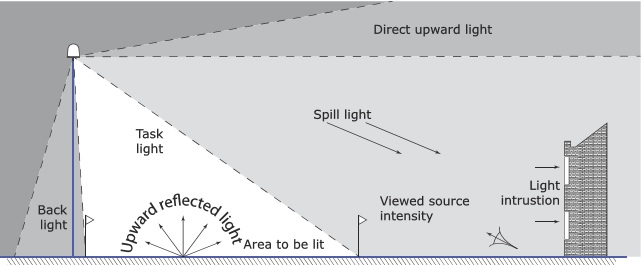In the world that we live in today, there are many forms and variations of light pollution and as a whole these are generically categorised as ‘obtrusive light’. Obtrusive light can be referred to as any light emitted in a direction in which it is not required or wanted and as such is detrimental to other potential users.
The diagram below demonstrates some of the different types of obtrusive light when specifically considered in relation to street lighting.

Figure 1.0: illustrates the different types of intrusive light taken from Guidance Notes for the Reduction of Obtrusive Light; 2020 Institution of Lighting Professionals (ILP).
Below we detail the individual labels on the diagram and try to give a better understanding of them:-
- Light intrusion refers to the spilling of light (Spill light) beyond the boundary of the area to be lit. This includes the intrusion of light into bedroom windows.
- Sky glow (Direct upward light) refers to the brightening of the sky above towns caused by direct or reflected upward light.
- Back light is the light falling from a luminaire into the area behind the lamp column and behind the area to be lit.
- Glare, although not shown on the diagram above, refers to the uncomfortable brightness of a light source when viewed against a dark background.
Obtrusive light, whether that is light shining through a window in your property or an artificial light source that is negatively affecting your ability to view the night time sky, is deemed as a form of pollution which is governed by law. Within the Clean Neighbourhoods and Environment Act 2005 (CNEA), light pollution was introduced as a form of statutory nuisance which was amended to include the following nuisance definition:
‘Sec 79(1)(fb) artificial light emitted from premises so as to be prejudicial to health or a nuisance’
By defining artificial light as “a nuisance” it pathed the way for LPA’s and the Environment Agency to have more authority to deal with the wide range of issues associated with artificial light from any given source. Although light was described within the act as having the potential to cause statutory nuisance, no prescriptive limits or rules were set for assessment. Which is why the Institute of Lighting Professionals (ILP) set about producing, and publishing, a ‘guidance note’ document called ‘Guidance Note 01/20 – Guidance notes for the reduction of Obtrusive Light’. The ILP’s guidance document is now commonly adopted in the UK as suitable lighting assessment criteria.
Guidance produced on S101 to S103 of the CNEA 2005 extends the duty on local authorities, to ensure their areas are checked periodically, for existing and potential sources of statutory nuisances including nuisances arising from artificial lighting. If and when a nuisance relating to artificial lighting arises, local authorities must take reasonable steps to investigate such complaints. Once investigated and satisfied that a statutory nuisance exists or may occur or recur, local authorities must issue an abatement notice (in accordance with s80(2) of the EPA 1990), requiring that the nuisance cease or be abated within a set timescale.
Artificial light is also now referenced in both National and Local planning policy. The National Planning Policy Framework (NPPF) stipulates that: “By encouraging good design, planning policies and decisions should limit the impact of light pollution from artificial light on local amenity…” Paragraph 7.19 of the London Plan states: “The lighting of the public realm also needs careful consideration to ensure places and spaces are appropriately lit, and there is an appropriate balance between issues of safety and security and reducing light pollution.” All of which points to a very worthy statement from the ILP guidance notes for the reduction of obtrusive light which states “Good lighting practise is the provision of the right light, at the right time, in the right place, controlled by the right system”.
Mitigating obtrusive light from impacting your development or scheme can be easily achieved by ensuring that you commission a suitably qualified street lighting design consultancy. Appropriately qualified designers will follow the relevant publications and design standards, whilst ensuring the use of appropriate lighting equipment to minimise the lighting impact on the surrounding environment and sensitive receptors.
Additional websites and reference documents can be found at the locations below:-
- http://www.legislation.gov.uk/ukpga/2005/16/contents
- https://theilp.org.uk/
- https://www.gov.uk/government/publications/national-planning-policy-framework–2
If you would like to discuss a lighting design with us, then please feel free to give us a call on 0118 321 5636. We will be more than happy to talk you through the best lighting approach and hopefully work with you to assist in gaining full planning permission for your project/development. Alternatively please send your enquiry to info@mma-consultancy.co.uk and we will get back to you as quickly as we possibly can.